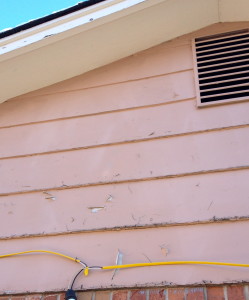Light Exterior Paint Color Can Save You Money
It can be fun to choose dark or bold colors when painting your the body of your home exterior. It adds punch and helps you stand out. But painting your whole house a dark or bright color may cost you more money!
Dark colors oxidize. Without getting too technical, dark colors fade and oxidize (display patches of white/fading) quickly. In Colorado the nearly constant sunshine is to blame.
Bright colors fade. Horribly. They don’t look nice for long when exposed to the elements. That great vivid shade could turn funky faster than a fruit salad.
How do I avoid this calamity?
Choose a light or medium color. Light colors camouflage damage and fade much less quickly.
When you care about your home looking crisp and fresh or have an HOA governing the appearance of the neighborhood, this saves you money in repainting costs. Big time.
What colors qualify as “light colors?”
- Choose colors on the top half of the gradient color swatch.
- Ask for a color that is mixed in a light/medium base. (Base is the liquid to which tint is added to make paint colors.)
Our next article, Use Fun Bold Colors to Accent Your Home Exterior, will show you how to use the colors you love to less expensively express your personality.
Quick DIY Inspection Can Save BIG on Exterior Painting
The BIGGEST budget-buster for exterior paint jobs is the prep work.
Untreated damage can lead to costly repair.
While proper prep makes or breaks the duration of your exterior paint job, what makes or breaks how much you spend on it is how much damage the painter must repair!
SECRET PRO SAVINGS TIP
The less time a painter spends repairing damage, the less money it costs you.
A simple annual check for these four common types of damage can save you big money on repainting costs. That is, of course, if you get your home repainted when the damage is minimal.
It’s super simple, too! Simply walk around your home and look for these four types of damage: peeling paint, trim and siding board damage, fading paint, and cracks between boards where they meet or overlap. (Photo examples are provided below.) Don’t forget to check your deck and fencing as well for signs of wear and tear!
When you notice one of these types of damage on your home call a local painter. Start gathering bids.
When you take care of your home’s exterior before damage gets out of hand, you save money year after year. When you choose a painter that does great prep and applies two coats of paint you will provide your home the best protection paint offers.
Disclaimer: This article assumes normal wear and tear for the Colorado Springs area and weather patterns. Massive weather events like hail, tornadoes, blizzards, etc. can accelerate and cause major damage. For more extreme weather events that cause damage, we suggest you check with your homeowner’s insurance carrier to see if they cover repairing the damage.








